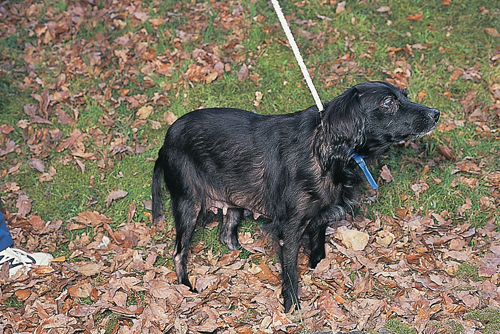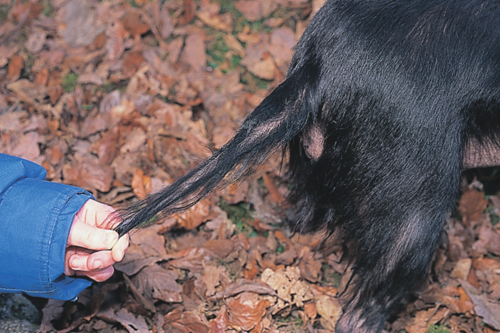Difference between revisions of "Small Animal Abdominal and Metabolic Disorders Q&A 17"
Ggaitskell (talk | contribs) |
|||
| (One intermediate revision by the same user not shown) | |||
| Line 1: | Line 1: | ||
| + | {{Manson | ||
| + | |book = Small Animal Abdominal and Metabolic Disorders Q&A}} | ||
| + | |||
[[File:SmAn Ab and Met 17a.jpg|centre|500px]] | [[File:SmAn Ab and Met 17a.jpg|centre|500px]] | ||
<br> | <br> | ||
| Line 17: | Line 20: | ||
Primary hypothyroidism due to lymphocytic thyroiditis or follicular atrophy is the most likely cause in an adult dog. | Primary hypothyroidism due to lymphocytic thyroiditis or follicular atrophy is the most likely cause in an adult dog. | ||
| − | |l1= | + | |l1=Hypothyroidism |
|q2=Is there an age or breed predisposition for this condition? | |q2=Is there an age or breed predisposition for this condition? | ||
|a2= | |a2= | ||
There appears to be a predisposition for middle-aged to older large breeds, particularly neutered females. | There appears to be a predisposition for middle-aged to older large breeds, particularly neutered females. | ||
| − | |l2= | + | |l2=Hypothyroidism#Signalment |
|q3=How would you confirm a diagnosis? | |q3=How would you confirm a diagnosis? | ||
|a3= | |a3= | ||
| Line 33: | Line 36: | ||
In primary hypothyroidism, circulating TSH concentrations are high in the face of a low total T4 concentration. | In primary hypothyroidism, circulating TSH concentrations are high in the face of a low total T4 concentration. | ||
| − | |l3= | + | |l3=Hypothyroidism#Diagnosis |
|q4=What is the recommended treatment? | |q4=What is the recommended treatment? | ||
|a4= | |a4= | ||
Sodium levothyroxine normalizes both circulating T4 and T3 concentrations. The initial dose is 20–22 mg/kg p/o q12–24h with further dose adjustments based on clinical response and post-pill testing. | Sodium levothyroxine normalizes both circulating T4 and T3 concentrations. The initial dose is 20–22 mg/kg p/o q12–24h with further dose adjustments based on clinical response and post-pill testing. | ||
| − | |l4= | + | |l4=Hypothyroidism#Treatment |
</FlashCard> | </FlashCard> | ||
Latest revision as of 15:05, 27 October 2011
| This question was provided by Manson Publishing as part of the OVAL Project. See more Small Animal Abdominal and Metabolic Disorders Q&A. |
This eight-year-old, neutered female dog presented with a four-month history of lethargy, bilaterally symmetric non-pruritic alopecia and a rat-tail.
| Question | Answer | Article | |
| What is the most likely diagnosis? | Hypothyroidism. Many endocrine diseases result in a non-pruritic alopecia but the development of a rat-tail appears to be a more common feature of hypothyroidism. Lethargy is also a relatively common sign of hypothyroidism. Primary hypothyroidism due to lymphocytic thyroiditis or follicular atrophy is the most likely cause in an adult dog. |
Link to Article | |
| Is there an age or breed predisposition for this condition? | There appears to be a predisposition for middle-aged to older large breeds, particularly neutered females. |
Link to Article | |
| How would you confirm a diagnosis? | Thyroid stimulating hormone (TSH) test/combined total T4 and endogenous TSH. Hypercholesterolaemia, mild normochromic normocytic anaemia and a low serum total T4 concentration support a diagnosis of hypothyroidism but can also occur in a variety of other diseases. Confirmation of a diagnosis has relied on demonstrating minimal or no increase in serum total T4 concentrations after administration of TSH or thyrotropin releasing hormone (TRH). Assaying endogenous canine TSH obviates the need for TSH stimulation. In primary hypothyroidism, circulating TSH concentrations are high in the face of a low total T4 concentration. |
Link to Article | |
| What is the recommended treatment? | Sodium levothyroxine normalizes both circulating T4 and T3 concentrations. The initial dose is 20–22 mg/kg p/o q12–24h with further dose adjustments based on clinical response and post-pill testing. |
Link to Article | |

